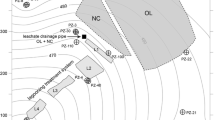Abstract
The hydrological tracing technique is an important tool for the risk assessment of problem sites, the so-called “Altlasten” (old underground contaminations). The penetration of leachate through the unsaturated zone, the transport velocity, the migration pathways, as well as the dispersion in the aquifer can be determined by tracing experiments. A wide range of tracers offer sufficient possibilities to get the necessary hydrogeologic parameters for any kind of Altlasten. This is shown by some examples.
Similar content being viewed by others
References
Knop A (1878) Über die hydrographischen Beziehungen zwischen der Donau und der Aachquelle im badischen Oberlande: N. Jb. Mineral (1878), pp 350–363
Käss W (1992) Geohydrologische Markierungstechnik, Band 9 des Lehrbuchs der Hydrogeologie, 529 p., Berlin: Gebr. Borntraeger Verlag
Käss W and Strayle G (1990) UVB-Verfahren aus der Sicht des Anwenders — Ergebnisse von Markierversuchen, In: Bock P, Hötzl H, Nahold M (Eds), Untergrundsanierung mittels Bodenluftabsaugung und In-Situ-Strippen, Karlsruhe: Schr. Angew. Geol. vol. 9. pp 291–304
Author information
Authors and Affiliations
Additional information
An English version of “Hydrologische Markierungstechnik bei der Altlastensanierung” in: Die Geowissenschaften, Weinheim 10(2): 199–205
Rights and permissions
About this article
Cite this article
Käss, W.A. Hydrological tracing practice on underground contaminations. Geo 23, 23–29 (1994). https://doi.org/10.1007/BF00773135
Received:
Accepted:
Issue Date:
DOI: https://doi.org/10.1007/BF00773135




